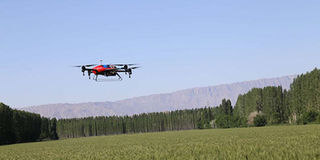Technology catalyst to achieving goals

A drone flies over a wheat field to spray insecticide at a farm of the Xinjiang Production and Construction Corps in Bayan Gol Mongolian Autonomous Prefecture, on June 9, 2015. Drones have the leapfrogging opportunity regarding precision agriculture. PHOTO | YAN ZHIJIANG
What you need to know:
- Critically, digital technologies can help the health of nations to thrive through the provision of affordable preventive and curative services.
- The academia, industry, politics and civil society should collaborate, communicate and build consensus on innovations to catalyse SDGs.
Rapid technological change can catalyse the 2030 Agenda for Sustainable Development.
Technological innovations can give policymakers an enabling platform and powerful tools to design and plan development interventions, according to the "United Nations Economic and Social Council 2019" report.
Big Data and machine learning can be used to create, measure and develop and monitor the effectiveness of development programmes and progress towards the Sustainable Development Goals (SDGs).
The “Global Pulse 2014” report shows proliferation of mobile phone technologies’ activity and airtime credit purchases estimate multidimensional poverty indicators accurately.
Secondly, Big Data, the Internet of Things (IoT), remote sensing, drones and artificial intelligence (AI) may catalyse precision farming, reducing the number of agrochemical inputs for existing agricultural processes, thus improving food security, nutrition and agricultural development countrywide.
FOOD SECURITY
Consequently, drones have the leapfrogging opportunity regarding precision agriculture, enabling more effective measurement of and response to variability in crop and animal production.
Genetic sequencing, along with machine learning, is being used to detect soil quality and help increase crop quality.
It is also being applied to drone and satellite imagery to build detailed weather models that help farmers make more informed decisions to maximise their yields.
It is also used with plant genomic and phenotypic data to predict the performance of new plant hybrids.
And farming is becoming increasingly automated, with robots being used to carry out the ecological and economical weeding of row crops.
This calls for the youth to equip themselves with proficiencies in this technology as income-generating ventures.
GOVERNANCE STRUCTURES
If rapid technological changes are to be harnessed for the various dimensions of food security, the food system itself must be made more innovative.
This creates ‘technopreneurship’ ventures in defining research agenda that focus on smallholder farmers, investing in human capacity and redesigning the infrastructure for food systems.
On the other hand, policymakers ought to put in place the appropriate governance structures for agricultural innovation and strengthening farmer-scientist knowledge flows.
Thirdly, as an enabler for economic diversification and transformation, productivity and competitiveness, technologies — along with science, technology and innovation policies, endogenous technological capacities and an enabling environment — have supported the productive upgrading of the economy in some developing countries.
For example, in November last year, the Common Market for Eastern and Southern Africa (Comesa) launched the 50 Million African Women Speak Project (50MAWS).
SMART GRIDS
The project envisions to provide an enabling economic and social empowerment arena for women across 38 African countries through provision of a networking platform to access market information on financial and non-financial services.
In promoting energy access and efficiency, the convergence of technologies is the interaction of smart grids between renewable technologies and data and artificial intelligence technologies.
For example, machine learning algorithms can be used to predict the output of wind farms, allowing scheduled energy delivery to the grid.
Energy production and distribution are also improved by allowing households with solar panels to feed surplus energy back into the electricity grid.
AI, coupled with innovative energy storage technologies, helps to address the intermittency of some forms of renewable energy through dynamic adjustment of supply and demand.
Advances in battery and other technologies are also improving the performance of electric vehicles.
HEALTHCARE
Digital platforms like massive open online courses provide online open access and unlimited participation through the internet, providing an open learning environment for all to access self-paced learning and data analytics avenues.
Critically, digital technologies can help the health of nations to thrive through the provision of affordable preventive and curative services.
Learners specialising in medicine-related courses have the autonomy to invoke their creativity and leverage on emerging technologies to innovate applications for universal health coverage.
The academia, industry, politics and civil society should collaborate, communicate and build consensus on innovations to catalyse SDGs and provide the youth with the creative and innovative space for ‘technopreneurship’.
Ms Okutoyi is a sustainability researcher/writer at Impact Africa; [email protected]. Ms Marangu is a planning and research officer at Kenya Film Classification Board; [email protected] @nancy_marangu





